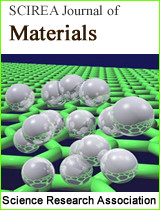The double torsion test for evaluation of fracture toughness of PLLA bioresorbable polymer during degradation
DOI: 440 Downloads 16099 Views
Author(s)
Abstract
Poly-l-lactic acid (PLLA) is widely used in the fabrication of bioresorbable orthopaedic and bone fixation devices. These implants degrade over time within the in vivo environment increasing the risk of potential mechanical failure. Therefore it is necessary to better understand the fracture behaviour of PLLA under physiological conditions during the degradation process. The aim of this work was to estimate how its fracture properties would change once a PLLA device has been implanted in a patient’s body and commenced degradation. PLLA specimens were compression moulded and degraded at 70 °C in PBS (the elevated temperature ensured accelerated degradation). As PLLA had rarely been studied using the double torsion (DT) test, some preliminary validation tests were also conducted in order to optimise the specimen geometry to achieve consistent behaviour. Tests were conducted after 1, 3 and 7 days of accelerated in vitro degradation. It was possible to determine the fracture toughness from the DT technique for up to 3 days of degradation. Fracture toughness deteriorated dramatically between 1 and 3 days of degradation from 4.45±0.42 to 2.06±0.20 MPam1/2. Beyond 3 days the extent of degradation prevented testing by the DT technique.
Keywords
double torsion test; bioresorbable polymer; poly-l-lactide, degradation, medical implants
Cite this paper
Marina Ferras Viana, Fraser J Buchanan,
The double torsion test for evaluation of fracture toughness of PLLA bioresorbable polymer during degradation
, SCIREA Journal of Materials.
Volume 1, Issue 1, October 2016 | PP. 37-49.
References
| [ 1 ] | Park, SD, Mitsugo, T, Arakawa, K and Koganemaru, M. Effect of crystallinity and loading-rate on mode I fracture behaviour of poly(lactic acid). Polymer 2006; 47: 1357-1363. |
| [ 2 ] | Todo, M, Park, S D, Takayama, T and Arakawa, K. Fracture micromechanisms of bioabsorbable PLLA/PCL polymer blends. . Engineering Fracture Mechanics 2007; 74: 1872-1883. |
| [ 3 ] | Arakawa, K, Mada, T, Park, SD and Todo, M. Tensile fracture behaviour of biodegradable polymer, poly(lactic acid). Polymer Testing 2006; 25: 628-634. |
| [ 4 ] | Grellmann, W. Characterization of toughness using fracture mechanics methods. In: Grellmann, W and Seidler, S (eds). Deformation and Fracture Behaviour of Polymers.1st ed. Berlin: Springer-Verlag Berlin Heideberg, 2011, pp3-8. |
| [ 5 ] | Williams, D. Fracture Mechanics of Polymers. 1st ed. Chichester : Ellis Horwood, 1984. |
| [ 6 ] | Becker, TH, Marrow, TJ and Tait, RB. An evaluation of the double torsion technique. Experimental Mechanics 2011, 51: 1511-1526. |
| [ 7 ] | Jiang, X, Yan, L, Tian, X, Huang, D, Reddy, N and Yang, Y. Chemical structure of poly(lactic acid). In: Auras, R, Lim, LT, Selke, SEM and Tsuji, H (eds). Poly(lactic acid): synthesis, structures, properties, processing and applications. 1st ed. Hoboken: John Wiley & Sons Inc, 2010, pp-71-80. |
| [ 8 ] | Cameron, RE and Kamvari-Moghaddam, A. Synthetic bioresorbable polymers. In: Fraser Buchanan (ed). Degradation rate of bioresorbable materials: prediction and evaluation. 1st ed. Boca Raton: WP and CRC Press, 2008, pp44-52. |
| [ 9 ] | Han, X, Pan, J, Buchanan, F, Weir, N and Farrar, D. Analysis of degradation data of poly(L lactide co L,D lactide) and poly(L lactide) obtained at elevated and physiological temperatures using mathematical models. Acta Bionaterialia 2010, 6: 3882-3889. |
| [ 10 ] | Weir, NA, Buchanan, FJ, Orr, JF, Farrar, DF and Dickson, GR. Degradation of poly-L-lactide. Part 2: increased temperature accelerated degradation. Proceedings of the Institution of Mechanical Engineers, Part H: Journal of Engineering in Medicine 2004, 218: 321-330. |
| [ 11 ] | Buckley, P. Mechanical properties of polymethyl methacrylate cement and bone composites. PhD Thesis, The Queen’s University of Belfast, UK, 2000. |
| [ 12 ] | Hill, RG, Bates, JF, Lewis, TT, Rees, N. The fracture of acrylic polymers in water. Journal of Materials Science 1984, 19: 1904-1916. |
| [ 13 ] | Weir, NA, Buchanan, FJ, Orr, JF, Farrar, DF, Boyd, A. Processing, annealing and sterilization of poly-L-lactide. Biomaterials 2004, 25: 3939-3949. |
| [ 14 ] | Park, SD, Mitsugo, T, Arakawa, K, Koganemaru, M. Effect of crystallinity and loading-rate on mode I fracture behaviour of poly(lactic acid). Polymer 2006, 47: 1357-1363 |
| [ 15 ] | Leevers, PS, Williams, JG. Material and geometry effects on crack shape in double torsion testing. Journal of Materials Science 1985, 20: 77-84. |
| [ 16 ] | Park, SD, Todo, M, Arakawa, K. Effect of annealing on the fracture toughness of poly(lactic acid). Journal of Materials Science 2004, 39: 1113-1116. |

